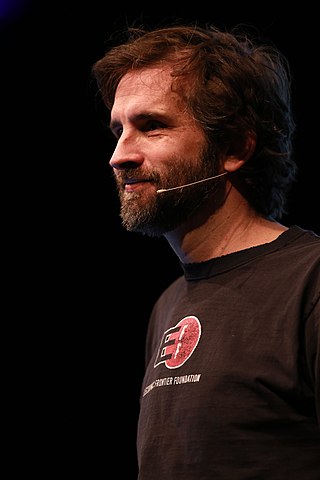
The Data Encryption Standard is a symmetric-key algorithm for the encryption of digital data. Although its short key length of 56 bits makes it too insecure for modern applications, it has been highly influential in the advancement of cryptography.

Philip R. Zimmermann is an American computer scientist and cryptographer. He is the creator of Pretty Good Privacy (PGP), the most widely used email encryption software in the world. He is also known for his work in VoIP encryption protocols, notably ZRTP and Zfone. Zimmermann is co-founder and Chief Scientist of the global encrypted communications firm Silent Circle.

Public-key cryptography, or asymmetric cryptography, is the field of cryptographic systems that use pairs of related keys. Each key pair consists of a public key and a corresponding private key. Key pairs are generated with cryptographic algorithms based on mathematical problems termed one-way functions. Security of public-key cryptography depends on keeping the private key secret; the public key can be openly distributed without compromising security.

Bruce Schneier is an American cryptographer, computer security professional, privacy specialist, and writer. Schneier is an Adjunct Lecturer in Public Policy at the Harvard Kennedy School and a Fellow at the Berkman Klein Center for Internet & Society as of November, 2013. He is a board member of the Electronic Frontier Foundation, Access Now, and The Tor Project; and an advisory board member of Electronic Privacy Information Center and VerifiedVoting.org. He is the author of several books on general security topics, computer security and cryptography and is a squid enthusiast.
Kerckhoffs's principle of cryptography was stated by Dutch-born cryptographer Auguste Kerckhoffs in the 19th century. The principle holds that a cryptosystem should be secure, even if everything about the system, except the key, is public knowledge. This concept is widely embraced by cryptographers, in contrast to security through obscurity, which is not.

Ronald Linn Rivest is an American cryptographer and computer scientist whose work has spanned the fields of algorithms and combinatorics, cryptography, machine learning, and election integrity. He is an Institute Professor at the Massachusetts Institute of Technology (MIT), and a member of MIT's Department of Electrical Engineering and Computer Science and its Computer Science and Artificial Intelligence Laboratory.
Daniel Dominic Kaplan Sleator is a Professor of Computer Science at Carnegie Mellon University, Pittsburgh, United States. In 1999, he won the ACM Paris Kanellakis Award for the splay tree data structure.

Daniel Julius Bernstein is an American mathematician, cryptologist, and computer scientist. He is a visiting professor at CASA at Ruhr University Bochum, as well as a research professor of Computer Science at the University of Illinois at Chicago. Before this, he was a visiting professor in the department of mathematics and computer science at the Eindhoven University of Technology.

The University of Colorado Boulder is a public research university in Boulder, Colorado, United States. Founded in 1876, five months before Colorado became a state, it is the flagship university of the University of Colorado system. CU Boulder is a member of the Association of American Universities and is classified among R1: Doctoral Universities – Very high research activity.
In cryptography, Camellia is a symmetric key block cipher with a block size of 128 bits and key sizes of 128, 192 and 256 bits. It was jointly developed by Mitsubishi Electric and NTT of Japan. The cipher has been approved for use by the ISO/IEC, the European Union's NESSIE project and the Japanese CRYPTREC project. The cipher has security levels and processing abilities comparable to the Advanced Encryption Standard.
A random password generator is a software program or hardware device that takes input from a random or pseudo-random number generator and automatically generates a password. Random passwords can be generated manually, using simple sources of randomness such as dice or coins, or they can be generated using a computer.

Zooko Wilcox-O'Hearn, is an American Colorado-based computer security specialist, self-proclaimed cypherpunk, and ex-CEO of the Electric Coin Company (ECC), a for-profit company leading the development of Zcash.
Lattice-based cryptography is the generic term for constructions of cryptographic primitives that involve lattices, either in the construction itself or in the security proof. Lattice-based constructions support important standards of post-quantum cryptography. Unlike more widely used and known public-key schemes such as the RSA, Diffie-Hellman or elliptic-curve cryptosystems — which could, theoretically, be defeated using Shor's algorithm on a quantum computer — some lattice-based constructions appear to be resistant to attack by both classical and quantum computers. Furthermore, many lattice-based constructions are considered to be secure under the assumption that certain well-studied computational lattice problems cannot be solved efficiently.

Cryptography, or cryptology, is the practice and study of techniques for secure communication in the presence of adversarial behavior. More generally, cryptography is about constructing and analyzing protocols that prevent third parties or the public from reading private messages. Modern cryptography exists at the intersection of the disciplines of mathematics, computer science, information security, electrical engineering, digital signal processing, physics, and others. Core concepts related to information security are also central to cryptography. Practical applications of cryptography include electronic commerce, chip-based payment cards, digital currencies, computer passwords, and military communications.

Cynthia Dwork is an American computer scientist best known for her contributions to cryptography, distributed computing, and algorithmic fairness. She is one of the inventors of differential privacy and proof-of-work.
Post-quantum cryptography (PQC), sometimes referred to as quantum-proof, quantum-safe, or quantum-resistant, is the development of cryptographic algorithms that are currently thought to be secure against a cryptanalytic attack by a quantum computer. Most widely-used public-key algorithms rely on the difficulty of one of three mathematical problems: the integer factorization problem, the discrete logarithm problem or the elliptic-curve discrete logarithm problem. All of these problems could be easily solved on a sufficiently powerful quantum computer running Shor's algorithm or even faster and less demanding alternatives.

Evi Nemeth was an engineer, author, and teacher known for her expertise in computer system administration and networks. She was the lead author of the "bibles" of system administration: UNIX System Administration Handbook, Linux Administration Handbook, and UNIX and Linux System Administration Handbook. Evi Nemeth was known in technology circles as the matriarch of system administration.
In cryptography, security level is a measure of the strength that a cryptographic primitive — such as a cipher or hash function — achieves. Security level is usually expressed as a number of "bits of security", where n-bit security means that the attacker would have to perform 2n operations to break it, but other methods have been proposed that more closely model the costs for an attacker. This allows for convenient comparison between algorithms and is useful when combining multiple primitives in a hybrid cryptosystem, so there is no clear weakest link. For example, AES-128 is designed to offer a 128-bit security level, which is considered roughly equivalent to a RSA using 3072-bit key.
Ran Canetti is a professor of Computer Science at Boston University. and the director of the Check Point Institute for Information Security and of the Center for Reliable Information System and Cyber Security. He is also associate editor of the Journal of Cryptology and Information and Computation. His main areas of research span cryptography and information security, with an emphasis on the design, analysis and use of cryptographic protocols.